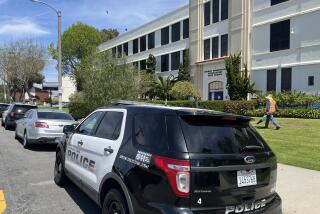Fear and Death Are Facts of Life in Gangs’ Turf
SANTA ANA — There was fear in the neighborhood encircling Santa Ana High School on Thursday, a day after the fatal shooting of a 32-year-old man who had been playing basketball with relatives at the school.
Some residents talked to each other over fences, some spoke car to car, as they shared the news about the tragedy in animated Spanish. For many, the gunshots and death are just the latest in a series of escalating acts of violence in their neighborhood.
“There are gunshots . . . around here all the time,” said Carmen Placencia, a resident on Parton Street, next to Santa Ana High and near where the shooting occurred.
Placencia’s neighborhood consists of dozens of stucco and wood-framed houses in a typically older community. It’s a place where Latino mothers urge their youngsters to do well in school, while Latino fathers work hard to put tortillas y carne on the supper table.
It is also occupied territory.
Name a Santa Ana gang, any gang, and the residents here will show you where the gang’s graffiti has been splashed on a wall. Name a hard-boiled cholo-- or gangster -- out to earn a reputation, and they’ll show you his street name--his placa --on another wall or sidewalk.
“We got gangs all around here,” said Placencia’s sister, Martha Barba, 19, who attends Rancho Santiago Community College and is trying to earn enough academic credits to transfer to San Diego State University. In a voice of frustration, she said, “I gotta get out of here.”
Others along Parton and nearby Camile and Flower streets say that the Myrtle Street Boys, barely half a block from the entrance to the school’s basketball courts, are in control of the neighborhood and are literally holding it under siege.
But there are other gangs in the area, Dogtown and F-Troop, who also enjoy coming into their barrio and shooting it up, leaving grim reminders such as bullet holes in stucco or worse, as evidence of the ongoing war within a mile of Civic Center.
“Once a car filled with boys drove by the apartments on Myrtle where the cholos live, and they just started shooting toward the apartments,” Placencia said. “I have a friend, and one of her sons was beaten up recently by these cholos. He had a six-pack of beer he bought at the liquor store and he got stopped by these guys. They wanted his beer. When he refused, they beat him up and took the beer.”
There is also irony in this neighborhood. A substantial number of its Spanish-speaking inhabitants came from Mexico. Guns and weapons, which can be found in quantity in even the smallest Mexican village, are not as plentiful as they are here, residents said.
“It’s getting dangerous,” said Maria Ortega, who had been visiting a friend’s house on Parton Street. “We hear stories of people simply passing the cholos on the street and they’ll start shooting at you if they don’t like you.”
Another resident who did not want to be identified simply put her hands up in frustration.
“I’m afraid. I’m afraid of complaining to the police or confronting these gang members. I want to do something, but what can I do?”
A decade ago, the neighborhood was still considered a nice place for families. But something happened, and many residents who tried explaining couldn’t quite pinpoint the reason for their neighborhood’s decline.
Some pointed to the hundreds of new renters in new apartments on Myrtle Street, many of whom emigrated from Mexico to escape that country’s depressed economy. Some placed blame on the availability of drugs or on the Reagan years. Some blamed an era of poor municipal budgets and the gripping recession that has left many out of work, under-skilled and with little to do.
Police say drug dealing near the high school and in the rest of the neighborhood exacerbates the problems of law enforcement. Rock cocaine, marijuana and heroin are now “common” drugs being bartered on the streets that intersect this community, said Lt. Jose Garcia, who oversees the patrol officers in the area near Santa Ana High School.
Patricia Rosell, 22, said she can recall with pride how she grew up in the neighborhood, and attended Santa Ana High School, where she graduated.
“When I was going to school, it was all calm,” she said. “But now it’s changed. I used to go out dancing on the weekends and sometimes come home around 2 or 3 in the morning. But not anymore. I try to come back home by about 11:30 p.m.”
Rosell’s brother, Juan, is the captain of the school basketball team and has frequented the school playground.
“He goes to play there all the time,” his sister said. “And now I’m scared because he goes to play over there and practice. I told him, ‘You see what happens! Don’t even go over there!
More to Read
Sign up for Essential California
The most important California stories and recommendations in your inbox every morning.
You may occasionally receive promotional content from the Los Angeles Times.










